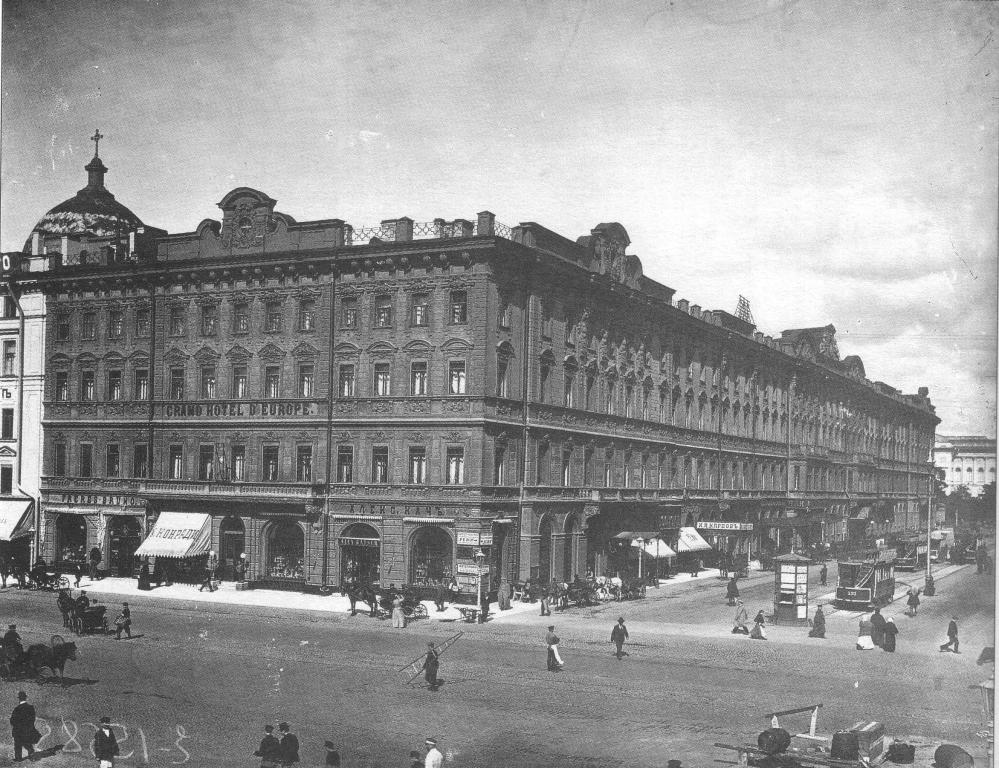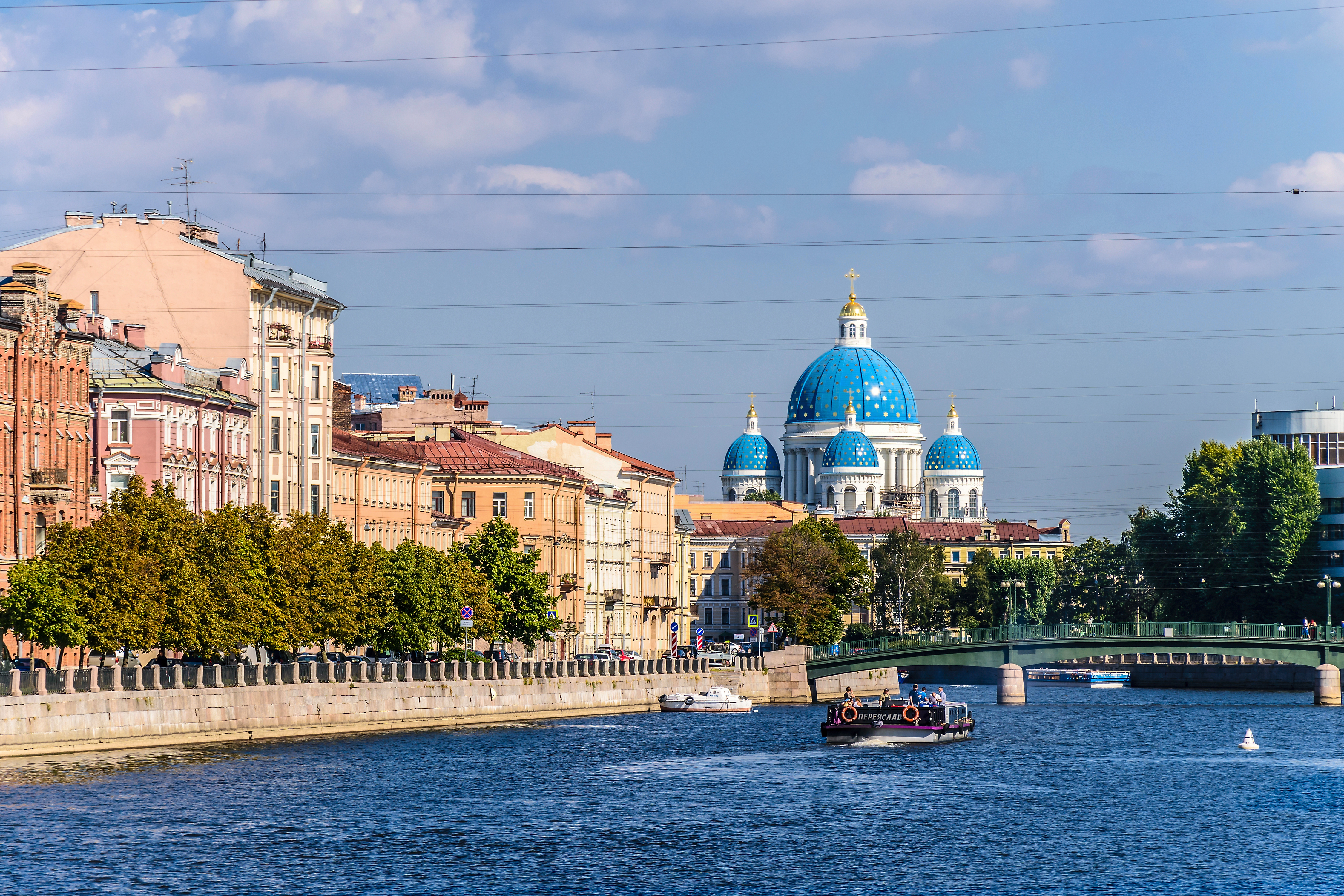|
Italyanskaya Street
Italyanskaya Street is a street in Saint Petersburg, Russia, which goes from the Griboyedov Canal to the Fontanka Embankment. It intersects with the Arts and Manezhnaya squares, as well as the Mikhailovskaya, Sadovaya, Malaya Sadovaya and Karavannaya streets. The street was named after the Italian Palace, which had been built there in 1739 and demolished in the early 19th century. The Ekaterininskiy Institute was built in its place. Between 1871 and 1902, the street was called Bolshaya Italyanskaya ('Big Italian'), while the modern Zhukovskogo Street was called Malaya Italyanskaya ('Small Italian'). Notable buildings Many buildings on this street are listed as cultural heritage objects: *№ 1 — House of Jesuits *№ 2/6 — Branobel house *№ 3 — Catholic Church of Saint Catherine *№ 7/1 — Grand Hotel Europe *№ 9/2 — Saint Petersburg Philharmonia *№ 23/12 — *№ 25 — Shuvalov Mansion *№ 27 — *№ 39/21 — Naryshkin-Shuvalov Palace The Naryshkin ... [...More Info...] [...Related Items...] OR: [Wikipedia] [Google] [Baidu] |
Saint Petersburg
Saint Petersburg ( rus, links=no, Санкт-Петербург, a=Ru-Sankt Peterburg Leningrad Petrograd Piter.ogg, r=Sankt-Peterburg, p=ˈsankt pʲɪtʲɪrˈburk), formerly known as Petrograd (1914–1924) and later Leningrad (1924–1991), is the second-largest city in Russia. It is situated on the Neva River, at the head of the Gulf of Finland on the Baltic Sea, with a population of roughly 5.4 million residents. Saint Petersburg is the fourth-most populous city in Europe after Istanbul, Moscow and London, the most populous city on the Baltic Sea, and the world's northernmost city of more than 1 million residents. As Russia's Imperial capital, and a historically strategic port, it is governed as a federal city. The city was founded by Tsar Peter the Great on 27 May 1703 on the site of a captured Swedish fortress, and was named after apostle Saint Peter. In Russia, Saint Petersburg is historically and culturally associated with t ... [...More Info...] [...Related Items...] OR: [Wikipedia] [Google] [Baidu] |
Griboyedov Canal
The Griboyedov Canal or Kanal Griboyedova () is a canal in Saint Petersburg, constructed in 1739 along the existing ''Krivusha'' river. In 1764–90, the canal was deepened and the banks were reinforced and covered with granite. The Griboyedov Canal starts from the Moyka River near the Field of Mars. It flows into the Fontanka River. Its length is , with a width of . Before 1923, it was called the Catherine Canal, after the Empress Catherine the Great, during whose rule it was deepened. The Communist authorities renamed it after the Russian playwright and diplomat, Alexandr Griboyedov. The streets or embankments running along the canal are known as ''Naberezhnaya Kanala Griboyedova''. Bridges There are 21 bridges across the canal: * Tripartite Bridge * Novo-Konyushenny Bridge * Italian Bridge * Kazansky Bridge * Bank Bridge * Flour Bridge * Stone Bridge * Demidov Bridge * Hay Bridge * Kokushkin Bridge * Voznesensky Bridge * Podyachensky Bridge * Bridge of ... [...More Info...] [...Related Items...] OR: [Wikipedia] [Google] [Baidu] |
Fontanka
The Fontanka (russian: Фонтанка), a left branch of the river Neva, flows through the whole of Central Saint Petersburg, Russia – from the Summer Garden to . It is long, with a width up to , and a depth up to . The Moyka River forms a right-bank branch of the Fontanka. Lined along the Fontanka Embankment stand the former private residences of Russian nobility. This river, one of 93 rivers and channels in Saint Petersburg, was once named ''Anonymous Creek'' (in Russian, ''Bezymyannyi Yerik'', ''Безымянный ерик''). In Russian, ''yerik'' is a secondary or intermittent river-channel ( creek or brook). In 1719 the river received its present name, because water from it supplied the fountains of the Summer Garden. Until the mid-18th century the Fontanka River marked the southern boundary of Saint Petersburg. Along its banks stood the spacious messuages of members of the Russian Imperial Family and of the nobility, the most brilliant being the Summer Pa ... [...More Info...] [...Related Items...] OR: [Wikipedia] [Google] [Baidu] |
Arts Square
The Arts Square (russian: площадь Искусств, ''Ploshchad Iskusstv'') is an open public square in the center of Saint Petersburg, Russia. History Before the construction of the Square, the land was the hunting grounds of the Empress Anna of Russia. Then Russian architect Francesco Bartolomeo Rastrelli (1700–1771) created a garden maze on the site. In the early 19th century, the Russian architect Carlo Rossi (1775–1849) was commissioned to develop the land between the Field of Mars and the Nevsky Prospect. The Mikhailovsky Palace, which now houses the main building of the Russian Museum, stood out as its most prominent building. Rossi also designed the Square, and the facades of the buildings facing Italianskaya Ulitsa and Mikhailovskaya Ulitsa. His work was completed by other architects with the Mikhailovsky Theatre, the Jaquot House, the Saint Petersburg Philharmonia, and the Mikhailovsky Square Garden at its center. From 1834 to 1918, the square was known as t ... [...More Info...] [...Related Items...] OR: [Wikipedia] [Google] [Baidu] |
Manezhnaya Square, Saint Petersburg
Manezhnaya Square (russian: Манежная площадь, romanized ''Manezhnaya ploschad'') is a square in the Tsentralny District of Saint Petersburg. In some guidebooks this square may be also named a ''Riding-School Square'':Eugene Fodor, Robert C. FisheFodor's Soviet Union.Fodor's Travel Publications, 1990 - 420 pages "riding school" is one of the variants in which french: manège and russian: манеж, translit=manezh may be translated. The shape of Manezhnaya Square is close to the right-angled triangle. Its longest cathetus, the southern side of Manezhnaya Square is formed with ''Italyanskaya Street'', which runs parallel to Nevsky Prospect, at about hundred meters north of it. The shortest cathetus is ''Karavannaya Street'', which forms the eastern side of the square running from Nevky prospect to the north. Another street connecting the square to Nevsky is ''Malaya Sadovaya'' which intersects Italyanskaya Street at the western corner of the square. Here converges ... [...More Info...] [...Related Items...] OR: [Wikipedia] [Google] [Baidu] |
Sadovaya Street
Sadovaya Street or Garden Street is a major thoroughfare in Saint Petersburg, Russia, passing through the historic city center. From east to west, it begins near the Field of Mars, crosses the Moika River at the First Sadovy Bridge, then passes over Spassky Island, the Kryukov Canal (at the Staro-Nikolsky Bridge), and Pokrovsky Island, before finally ending at the junction of the Griboyedov Canal and the Fontanka River. The section from the Moika to Gorokhovaya Street belongs to the Central District of the city, and the rest, to the Admiralteysky District. The street is 4376 m in length and about 8 m in width, and the distance between the buildings can be up to 18 m. The street has great cultural and historical significance, passing by many historical and architectural monuments from the 18th, 19th, and 20th centuries, including the Mikhailovsky, Vorontsov, and Moika (Yusupov) palaces. The street serves many important transportation functions, linking the central areas ... [...More Info...] [...Related Items...] OR: [Wikipedia] [Google] [Baidu] |
Malaya Sadovaya Street
Malaya Sadovaya Street (russian: Малая Садовая Улица, meaning 'Little Garden Street') is a pedestrian street of cafes, terraces and fountains in the heart of Saint Petersburg, Russia. It runs between Italyanskaya Street (Italian Street) and the Nevsky Prospect. Spanning a single block, at about , it is known as Saint Petersburg's shortest street. The street's Nevsky Prospect terminus is at Catherine Square, which features the monument to Catherine the Great by the sculptors Mikhail Mikeshin and Matthew Chizhov, and the architects Victor Schröter and David Grimm. At the Italyanskaya Street terminus is Manezhnaya Square, where there is a view of the portico of the great stables designed by Vincenzo Brenna and Karl Rossi. History The street, then called New Lane (russian: Новым переулком), was first made in the 1740s. A palace belonging to Ivan Shuvalov was built here, completed in 1756, after which the street was called Shuvalov Lane. All the odd ... [...More Info...] [...Related Items...] OR: [Wikipedia] [Google] [Baidu] |
Society Of Jesus
, image = Ihs-logo.svg , image_size = 175px , caption = ChristogramOfficial seal of the Jesuits , abbreviation = SJ , nickname = Jesuits , formation = , founders = , founding_location = , type = Order of clerics regular of pontifical right (for men) , headquarters = Generalate:Borgo S. Spirito 4, 00195 Roma-Prati, Italy , coords = , region_served = Worldwide , num_members = 14,839 members (includes 10,721 priests) as of 2020 , leader_title = Motto , leader_name = la, Ad Majorem Dei GloriamEnglish: ''For the Greater Glory of God'' , leader_title2 = Superior General , leader_name2 = Fr. Arturo Sosa, SJ , leader_title3 = Patron saints , leader_name3 = , leader_title4 = Ministry , leader_name4 = Missionary, educational, literary works , main_organ = La Civiltà Cattoli ... [...More Info...] [...Related Items...] OR: [Wikipedia] [Google] [Baidu] |
Branobel
The Petroleum Production Company Nobel Brothers, Limited, or Branobel (short for братьев Нобель "brat'yev Nobel" — "Nobel Brothers" in Russian), was an oil company set up by Ludvig Nobel and Baron Peter von Bilderling. It operated mainly in Baku, Azerbaijan, but also in Cheleken, Turkmenistan. Originally established by Robert Nobel (who contributed 25,000 rubles) and the investments of barons Peter von Bilderling (300,000 rubles) and Standertskjöld (150,000 rubles) as a distillery in 1876, it became, during the late-19th century, one of the largest oil-companies in the world. History The Nobel Brothers Petroleum Company was an oil-producing company that had its origins in a distillery, founded by Robert and Ludvig Nobel in Baku in 1876, which, in 1879, turned into a shareholding company headquartered in St. Petersburg. The share capital of three million rubles was divided as follows: 53,7% Ludwig Nobel, 31,0% Baron Peter von Bilderling, 4,7% I.J. Zabelskiv, 3,8% ... [...More Info...] [...Related Items...] OR: [Wikipedia] [Google] [Baidu] |
Church Of St
Church may refer to: Religion * Church (building), a building for Christian religious activities * Church (congregation), a local congregation of a Christian denomination * Church service, a formalized period of Christian communal worship * Christian denomination, a Christian organization with distinct doctrine and practice * Christian Church, either the collective body of all Christian believers, or early Christianity Places United Kingdom * Church (Liverpool ward), a Liverpool City Council ward * Church (Reading ward), a Reading Borough Council ward * Church (Sefton ward), a Metropolitan Borough of Sefton ward * Church, Lancashire, England United States * Church, Iowa, an unincorporated community * Church Lake, a lake in Minnesota Arts, entertainment, and media * '' Church magazine'', a pastoral theology magazine published by the National Pastoral Life Center Fictional entities * Church (''Red vs. Blue''), a fictional character in the video web series ''Red vs. Blue'' ... [...More Info...] [...Related Items...] OR: [Wikipedia] [Google] [Baidu] |
Grand Hotel Europe
The Grand Hotel Europe, A Belmond Hotel (russian: Гранд Отель Европа) is a historic Hotel rating, five-star luxury hotel on Nevsky Prospect in Saint Petersburg, Russia. History One of the great hotels of 19th-century Europe, the Grand Hotel d'Europe opened on 28 January 1875, replacing an earlier inn situated on the same site. In the 1910s, the hotel was remodeled in the Art Nouveau style to designs by Fyodor Lidval and Leon Benois. During the Russian Soviet Federative Socialist Republic, Soviet period, the hotel was known as the Hotel Evropeiskaya. It was completely restored between 1989 and 1991 and reopened in December 1991, managed by the Swedish Reso Hotels chain as the Reso Grand Hotel Europe.https://www.latimes.com/archives/la-xpm-1993-06-22-wr-5856-story.html The hotel was featured in the 1995 James Bond movie ''GoldenEye''. However, the movie was not filmed at the hotel, the exterior used was actually the Langham Hotel, London, while the interiors we ... [...More Info...] [...Related Items...] OR: [Wikipedia] [Google] [Baidu] |







